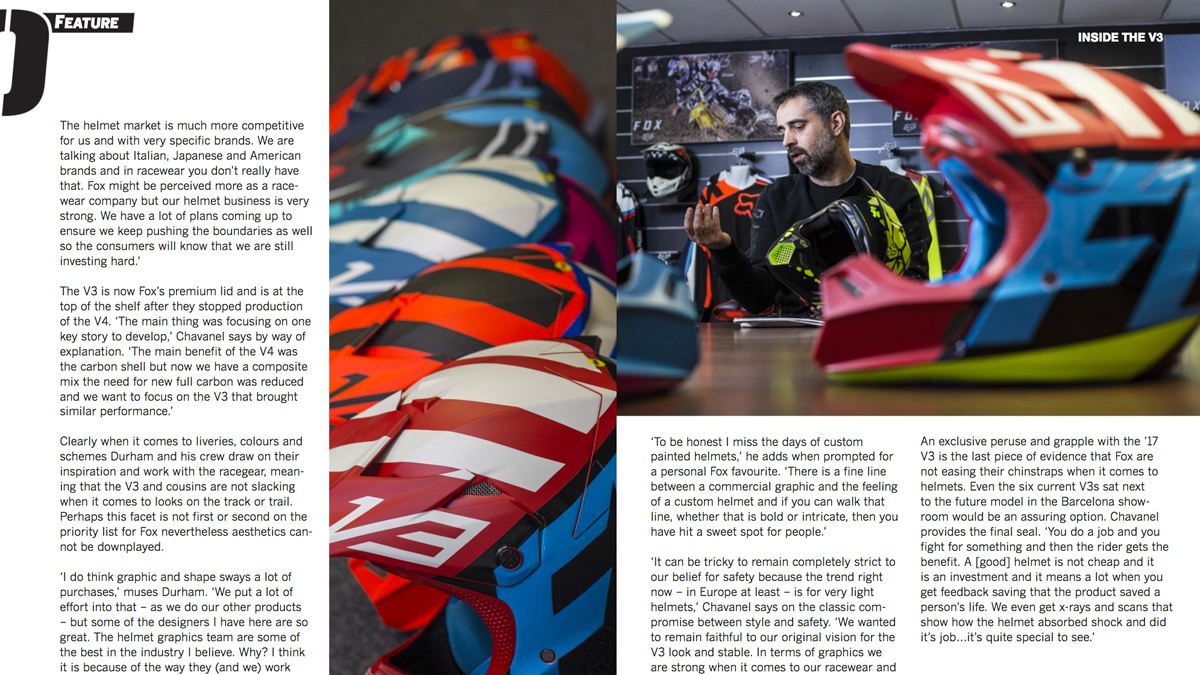From Irvine, California to Barcelona, Catalunya we went in search of this famous product – used by the likes of Roczen, Dungey, Reed, Paulin no less – and to find out just how much of a big deal it is for the American apparel and racewear giants…
We’ve explored some aspects of Fox in previous issues – their design philosophy and how it feeds into the fabrication of slightly different and advanced projects like their Instinct boots – but why focus on their V3 helmet? Maybe Fox is not the first name that springs to mind when it comes to head protection, after all they have the cool gear and desirable lifestyle range but is it the first port of call for arguably one of the most expensive and important purchases you’ll make for riding? We were unsure. It’s possible to ride head-to-toe in Fox but we were dubious as to whether we’d want to.
Some curiosity in the role of the V3 was sparked on a visit to their office/site/design hub in Irvine late last summer. The main entrance carries the distinctive form of the V3 mouthguard area; hardly a light cosmetic choice if the helmet does not carry some sort of pride-of-place or importance. There was also the history. No doubt athletes like McGrath, Carmichael, Stewart and many more were paid handsome dollars to be Fox athletes but they were also of sufficient stature and experience to shun any obligations to inferior offerings. Asking a bit more about whether the V3 should be considered a serious player in the saturated helmet market is met with information that it hits sales of around 50,000 per year in Europe alone, was one of the first to embrace MIPS technology, is the most successful helmet in American motocross and supercross and is the subject of a major redesign for 2017.
The details of the forthcoming V3 remain secret until the summer launch but a shrewd study of the lids worn by Ryan Dungey and Ken Roczen (when the German makes it back onto the Supercross floor) will reveal some clues towards a detail of innovation that shouldn’t really work but surprisingly does. Acute observation of the profile of the V3 will also come under the microscope.
In a sense some of our doubts about Fox’s intentions for helmets have been addressed but it doesn’t hurt to listen to the conviction of the staff themselves, and long-term Fox people like Mark Finley – Global Category Director – Dave Durham – Creative Director – and Christophe Chavanel – EMEA Brand Manager – don’t just spout sales speak at you. After all, the level of efficiency regarding this particular item can have mortal consequences. ‘The helmet category in general is very important to us as it protects our largest investment (our pro riders globally),’ offers Finley. ‘The V3 is the first product in our catalogue; it sets the tone for the rest of the book. We want to customers to see the engineering that has gone into this product. The current V3 had our own in-house CAD designer working for over a year to perfect the design from the inside out. Safety, construction and performance were key factors for the design and development team.’
‘We put a lot of effort into helmets and that area of protection in general,’ backs up Durham, who overseas all aspects of the lid. ‘We have some amazing manufacturing capabilities and we are constantly trying to find ways to benefit the user and consumer: we all wear helmets ourselves you know? I wear the V3 every time I ride.’

In Barcelona and at Fox’s European HQ Christophe Chavanel – who will soon transfer to Irvine – also talks about the primary role of the V3 and highlights the vicious crash by Paulin in the Qualification Heat for last year’s Grand Prix of France (after which the Frenchman was fit and ready to compete less than two weeks later in Britain) as a job well done by the protection. ‘It is two-three years now and I think it was the first helmet on the market to have the MIPS system,’ he says before hinting that Fox could potentially reach the point where they have their own form of engineering to address rotational acceleration [more on this subject next issue] like 6D, Leatt and Bell have pioneered. ‘The idea is to probably look for our own system and this could be one project for the Moto-X Lab. It is a lot of research and the truth is that the MIPS system is very well perceived. At Fox we are also working a lot in mountain bike and we know MIPs and the benefits well from that side and wondered why it could not work also in motocross. The intention of protection is to reduce the effects of a crash; you will never remove then completely just as there will always be crashes! MIPS made some very interesting studies with different crashes.’
‘There are a lot of great helmet brands out there and I think we all have one intention in mind and that’s to make everyone safer on the bike,’ says Durham from his elevated office position in California where the V3 is designed and then sent to a long-term manufacturing partner in China [‘A lot of the product development staff from the U.S. office are travelling frequently to Asia to make sure what we are designing and testing is a perfect match,’ says Chavanel of the link].
Durham of course is at the forefront of the V3 and its relevance as one of the contenders in the vast choice when it comes to off-road helmet. From features on the new version it is clear to see that his team have been busy and fairly imaginative but the current helmet on the shelves also has an attention-grabbing set of specs and close examination – under the catching graphics and gloss – shows careful detail on items such as placement of vents and the use of composites. ‘Ten years ago you’d never have heard of a fabric inside that would wick away humidity or sweat and now our whole helmet has this material,’ says Chavanel. ‘It seems like every season there is a new material to work with. Of course we cannot change the construction of the helmet every season but we have managed to take the benefit of every fabric at our disposal and we mix them to get the best resistance possible and also make gains on things like weight. So we have these new composites and with the latest helmet we don’t have a carbon shell but we have carbon elements inside to reduce the weight. There is no compromise on safety but there is an improvement in the experience of wearing it for the rider.’
‘We have an Advanced Concepts group at Fox that was put into place about a year and a half ago,’ Durham says. ‘We have a lot of resources being put towards helmets and boots and protection. We really think it is an important part of what we can bring to the sport.’
Naturally this must be something of a budget swallower and in a company that also has hundreds of other products and apparel it is must be a case of the V3 fighting for elbowroom. ‘Absolutely!’ the designer gasps. ‘It is not cheap to do anything like that and also just jump in and be ready to walk away from an idea that you have spent a lot of money on. We believe in it, and that’s from the top down.’
To finish reading the article simply click HERE to go to the magazine








